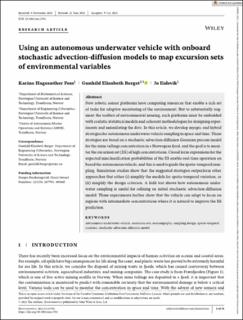| dc.contributor.author | Foss, Karine Hagesæther | |
| dc.contributor.author | Berget, Gunhild Elisabeth | |
| dc.contributor.author | Eidsvik, Jo | |
| dc.date.accessioned | 2022-10-14T07:37:02Z | |
| dc.date.available | 2022-10-14T07:37:02Z | |
| dc.date.created | 2021-09-16T15:55:32Z | |
| dc.date.issued | 2021 | |
| dc.identifier.citation | Environmetrics. 2021, 33 (1), . | en_US |
| dc.identifier.issn | 1180-4009 | |
| dc.identifier.uri | https://hdl.handle.net/11250/3026065 | |
| dc.description.abstract | New robotic sensor platforms have computing resources that enable a rich set of tasks for adaptive monitoring of the environment. But to substantially augment the toolbox of environmental sensing, such platforms must be embedded with realistic statistical models and coherent methodologies for designing experiments and assimilating the data. In this article, we develop myopic and hybrid strategies for autonomous underwater vehicle sampling in space and time. These strategies are based on a stochastic advection-diffusion Gaussian process model for the mine tailings concentration in a Norwegian fjord, and the goal is to monitor the excursion set (ES) of high concentrations. Closed form expressions for the expected misclassification probabilities of the ES enable real-time operation on board the autonomous vehicle, and this is used to guide the spatio-temporal sampling. Simulation studies show that the suggested strategies outperform other approaches that either (i) simplify the models for spatio-temporal variation, or (ii) simplify the design criterion. A field test shows how autonomous underwater sampling is useful for refining an initial stochastic advection-diffusion model. These experiments further show that the vehicle can adapt to focus on regions with intermediate concentrations where it is natural to improve the ES prediction. | en_US |
| dc.language.iso | eng | en_US |
| dc.publisher | Wiley | en_US |
| dc.rights | Attribution-NonCommercial-NoDerivatives 4.0 Internasjonal | * |
| dc.rights.uri | http://creativecommons.org/licenses/by-nc-nd/4.0/deed.no | * |
| dc.title | Using an autonomous underwater vehicle with onboard stochastic advection-diffusion models to map excursion sets of environmental variables | en_US |
| dc.type | Peer reviewed | en_US |
| dc.type | Journal article | en_US |
| dc.description.version | publishedVersion | en_US |
| dc.source.pagenumber | 18 | en_US |
| dc.source.volume | 33 | en_US |
| dc.source.journal | Environmetrics | en_US |
| dc.source.issue | 1 | en_US |
| dc.identifier.doi | 10.1002/env.2702 | |
| dc.identifier.cristin | 1935056 | |
| dc.relation.project | Norges forskningsråd: 223254 | en_US |
| dc.relation.project | Norges forskningsråd: 305445 | en_US |
| cristin.ispublished | true | |
| cristin.fulltext | preprint | |
| cristin.qualitycode | 1 | |

